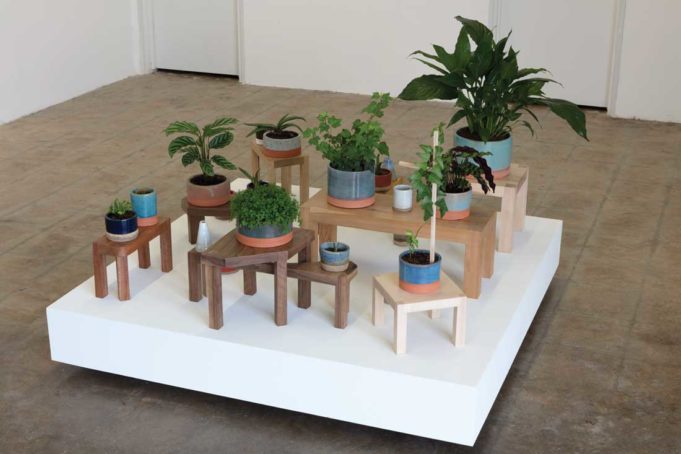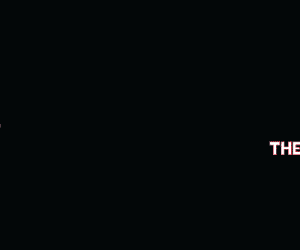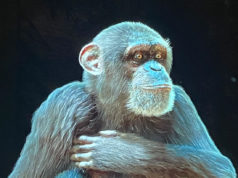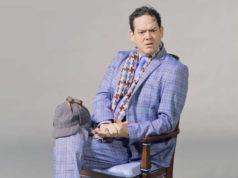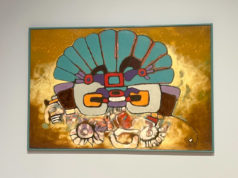In a bright, LED-lit gallery nestled between the industrial and design districts of Dallas are precisely crafted wood and metal sculptures that lie somewhere between the rigidity of formalism and the serenity of minimalism.
The subject of minimalism is something I’ve been thinking about for the past couple of weeks while working with area high school students around Agnes Martin and Fred Sandback. As we created self-portraits using information unique to ourselves while referring to the forms and systems of these two artists, a colleague referred me to this quote from Sandback: “I left the model of such discrete sculptural volumes for a sculpture which became less of a thing in itself, more of a diffuse interface between myself, my environment, and others peopling that environment.”
Ryan Goolsby’s exhibition at Liliana Bloch Gallery, Totem is a collection of works that are manifestations of everyday objects that Goolsby observes and contemplates for their simplicity of form and their mundane invisibility. Bike racks, cast iron radiators, faded signs –– they all come under scrutiny as objects to be translated into wood, paint, and metal.
Although the materials and the installation itself lean toward minimalism (every piece is untitled), Goolsby’s consideration of subject matter somewhat distances the exhibit from being considered minimalism in the strictest sense. The totems are reduced to pure form and material, often mimicking or complementing the architecture of the space itself. But because they are so strongly connected to recognizable objects, it’s easy to think about the real things while looking at Goolsby’s pieces.
In one piece, Goolsby offers a single undulating line of maple wood painted red across a horizontal plane, connected to the wall by two separate pieces of pine. (Imagine the red-hot heating element of an electric oven or stove burner.) The form is a simple glyph that immediately suggests a code, a hidden meaning, or an idea, and it delves deep into meaning of things, away from form and minimalism.
Totem, in its ambiguity, recalls the PBS documentary Containment, about the problem of how to label nuclear waste as dangerous for future generations. Even in the age of globally accessible information, the meaning of symbols doesn’t always translate across cultures, and a skull and crossbones could easily be interpreted as something other than “danger.”
In his awareness of this duality, Goolsby acknowledges in his artist statement that “at their core, they are still stationary items, simply ‘things’ onto which we project the desire for purpose, the need for there to be a reason.”
Other objects in Goolsby’s exhibition give recognizable nods to artists in the pantheon of minimalism. The blocks of pine that he employs as bases for his collection of untitled metal sculptures can be viewed as love letters to Carl Andre’s “Tau and Threshold (element series)” in the collection at the Modern Art Museum of Fort Worth. And Goolsby would have seen this sculpture, and others at the Modern, as a graduate student in TCU’s MFA program five years ago.
One other piece in Totem completely (and literally) stands apart from the other works in the show while providing context for and insight into Goolsby’s studio practice. “Untitled” with potted plants is a collection of painted ceramic pots, each holding a variety of small plants, atop tables and plinths, near the entrance of the gallery. This pivot to relational aesthetics isn’t completely out of context for Goolsby. As a former cohort of Fort Worth’s Homecoming Collective, Goolsby was on hand for some of the collective’s most inventive gestures, such as MacGuffin, an experience involving a hot tub and balloon blowing, complete with palm trees and a musical performance, and Hands on an Art Body, a contest in which contestants kept gloved hands on gallery art (including potted plants) until they were the last ones in contact with the pieces. The winners got to keep them. “Untitled” with potted plants complements the duality in the other sculptures and is evidence of the process that results in the pieces that became Totem. Goolsby used remnants of the wood and paint from the final objects to display his first attempts at throwing ceramic pots. This space “between the environment and others peopling that environment,” as Sandback describes it, is as good a starting point in understanding and appreciating Totem as is looking at these objects as forms to be appreciated.
Totem
Thru Feb 11 at Liliana Bloch Gallery, 2271 Monitor St, Dallas. Fee. 214-991-5617.



